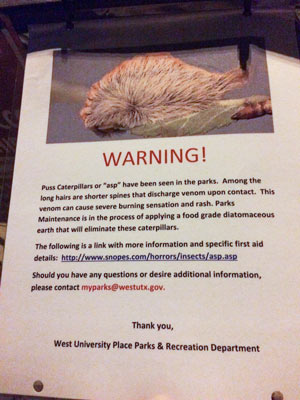ADORABLE VENOMOUS CATERPILLARS BACK ON THE CRAWL FROM SEABROOK TO WEST U  ‘Tis the season for stinging asps, notes Kaitlin McCulley while recounting a Seabrook resident’s recent encounter with one of the critters (also known as the puss caterpillar or, on occasion, the “toxic toupee”). The woolly caterpillars, whose delicate venomous spines are known to cause reactions in children such as 5-hour screaming fits and to necessitate the occasional emergency room visit in adults, are up in numbers for the fall as per usual, though their population and season varies from year to year depending on weather and food conditions. Over in West University, a sign currently hanging on the gate of Weir Park notes that the city’s parks folks will be putting out diatomaceous earth to kill the asps they’d spotted; the caterpillars have also been sighted (or felt) lately near the Harbach-Ripley Neighborhood Center in Golfcrest and in Lost Creek Park in Sugar Land. [ABC13] Photo of puss caterpillar warning sign in Weir Park, 3012 Nottingham St.: Swamplot inbox
‘Tis the season for stinging asps, notes Kaitlin McCulley while recounting a Seabrook resident’s recent encounter with one of the critters (also known as the puss caterpillar or, on occasion, the “toxic toupee”). The woolly caterpillars, whose delicate venomous spines are known to cause reactions in children such as 5-hour screaming fits and to necessitate the occasional emergency room visit in adults, are up in numbers for the fall as per usual, though their population and season varies from year to year depending on weather and food conditions. Over in West University, a sign currently hanging on the gate of Weir Park notes that the city’s parks folks will be putting out diatomaceous earth to kill the asps they’d spotted; the caterpillars have also been sighted (or felt) lately near the Harbach-Ripley Neighborhood Center in Golfcrest and in Lost Creek Park in Sugar Land. [ABC13] Photo of puss caterpillar warning sign in Weir Park, 3012 Nottingham St.: Swamplot inbox





My daughters and I saw them at Bendwood Park on Sunday. Very cute. Another park goer gave us the heads up on their venomousness thankfully.
I was stung by one of these in Austin and it was extremely painful.
I am familiar with the Diatomaceous earth as I used it during a flea problem. One strange thing is that it kills almost every type of insect. Is West U not concerned with the plight of pollinators?
Yikes – I thought they only had things like this in Australia.
The “toxic toupee?” How timely!
DE is put out to kill caterpillars and slugs and snails because it is like crawling ovee broken glass for these critters. Pollinators generally all fly, so they would not be affected.
do these things turn into anything, like murderous butterflies?
Here’s a wikipedia link on the creature https://en.wikipedia.org/wiki/Megalopyge_opercularis
Oh….you mean “asps.” Those stinging furry caterpillars have always been around. We knew from a young age to watch out for asps (they like to crawl on the trunks of oak trees and fences made of rough cedar wood, where the asps blend in quite well — it’s part of their natural camouflage. There’s about a dozen species of asps and they come in a variety of colors, all “fuzzy”: white, gray/white, brown, gold — it depends on the moth genera. Most of the asps I’ve seen are gray or off-white.
.
My older brother was stung a few times, just by accidentally brushing against an asp on the trunk of an oak tree. Your skin will get small, raised welts from where the barbs of the asp touch you. We didn’t know the trick of pulling out the barbs using scotch tape — mom just washed the welt and applied a soothing ointment like Lidocaine. My brother would whine a bit and got over it. He certainly didn’t scream and cry for five hours.
.
BTW, the asps are the caterpillar stage of the “Flannel Moth” or “Puss Moth” which oddly enough, I’ve never seen an adult moth in all the decades I’ve lived in Houston. My brother and I were avid insect collectors when we were kids and we caught pretty much every species of moth and butterfly (even a few Luna moths!), but we never found an adult Flannel Moth.
One of these got me on October 5th. I saw one, knew it was poisonous, carefully picked it up and destroyed it. However that same day I knelt down and another one got me full on. Top of my foot. Painful enough that you could have done surgery without anesthesia on my other leg and I wouldn’t have noticed. About a 8.5-9 on my pain scale. The worst pain was nowhere near the sting site. It moves. In my case, up to my inner thigh. Since then I’ve found three more around my backyard, which brings the total to five.